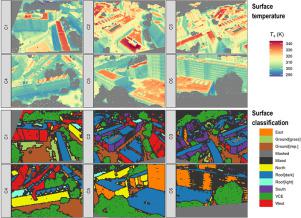Urban Climate ( IF 6.0 ) Pub Date : 2020-12-24 , DOI: 10.1016/j.uclim.2020.100748 William Morrison , Simone Kotthaus , Sue Grimmond

|
Ground based thermal cameras are used to observe urban surface temperatures (Ts) with an unprecedented combination of: temporal and spatial resolution (5 min and ~ 0.5 m → 2.5 m), spatial extent (3.9 ha), instrument number (6 static cameras) and surface heterogeneity (mixed high rise and vegetation). Unsupervised classification of images by geometry and material properties (surface orientation, albedo, solar irradiance, and shadow history) is facilitated by a detailed three-dimensional surface model (430 m × 430 m extent) and sensor view modelling. From detailed source area analysis, 9.5% of the area is observed by the cameras. Across all camera pixels, the 5th - 95th percentile Ts differences reach 37.5 K around midday. Roofs have the greatest diurnal Ts range (290.6 K → 329.0 K). Ts differences across sunlit sloped roofs reach 23.3 K. Walls of different cardinal orientations consistently differ by >10 K between 10:00 and 15:00. Shadow tracking within images is used to model cooling rates, where recently shaded (<30 min) ground can be 18.6 K warmer than equivalent unshaded Ts. West walls remain warm past sunset and are 1.2 K warmer than north walls at 23:00 (~4 h after sunset). Recently shaded walls cool exponentially to ambient Ts at a similar rate as the ground, but four times slower than roofs. The observed Ts characteristics are anticipated to have a wide range of applications (e.g. evaluation of urban surface energy balance models, ground-truthing of satellite thermal remote sensing).
中文翻译:

基于地面热成像的城市表面温度观测:面内和面间变异性
基于地面的热像仪以前所未有的组合方式用于观测城市表面温度(T s):时间和空间分辨率(5分钟和〜0.5 m→2.5 m),空间范围(3.9公顷),仪器数量(6台静态热像仪) )和表面异质性(混合高层和植被)。通过详细的三维表面模型(430 m×430 m范围)和传感器视图建模,可以按几何形状和材料属性(表面方向,反照率,太阳辐照度和阴影历史记录)对图像进行无监督分类。通过详细的源区域分析,摄像机可以看到9.5%的区域。在所有相机像素中,第5个百分点至第95个百分点的T s差在午夜左右达到37.5K。屋顶日间最大T s范围(290.6 K→329.0 K)。Ť小号跨越阳光照射的差异倾斜屋顶到达不同基数取向23.3 K.墙壁一贯> 10 K的10:00和15:00之间。图像中的阴影跟踪用于建模冷却速率,最近的阴影(<30分钟)地面比等效的非阴影T s温暖18.6K 。西墙在日落后仍保持温暖,并在23:00(日落后约4小时)比北墙高1.2K。最近被遮蔽的墙以与地面相似的速率指数冷却至周围温度T s,但比屋顶慢四倍。所观察到的Ť小号 预期这些特性将具有广泛的应用(例如,评估城市表面能平衡模型,卫星热遥感的地面实况)。











































 京公网安备 11010802027423号
京公网安备 11010802027423号